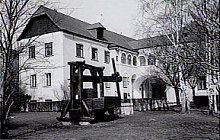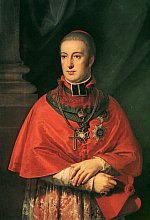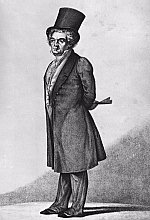The conversation notebooks137 of these so-called conversation notebooks are preserved today, they are an informative source for Beethoven's live from 1818 to 1827. The importance of the material is first of all that it conveys an idea of Beethoven's living, thorough explanations of his composing method are rather infrequent. Among other things the detailed records provide information on the preparation of the première of the ninth symphony op 125 on May 7th 1824, but they report also on family affairs, such as Karl's suicide attempt. A multitude of personal notes, shopping lists, sketches of letters, transcripts of newspaper advertisements and even composition sketches are among the entries. But the enormous wealth of information must be taken with a pinch of salt. On the one hand, the records repeat almost exclusively the statements of the interlocutors, on the other hand, not all of Beethoven's conversations have left written marks, because some of his friends and acquaintances (such as Archduke Rudolf) continued to converse with him verbally despite his infirmity. Another factor is that, after the death of the composer, the notebooks
passed into Anton Schindler's possession, who was his assistant since 1819
and wrote the first biography of Beethoven later. Schindler threw numerous
entries in afterwards to give himself the air of having been in close contact
to Beethoven. But in the last three decades scientists succeeded in identifying
Schindler's faked passages. Since the sixties, a team of the German national
library, where most of the conversation notebooks are, works on a well-founded
scientific ten-volume edition of the extensive material.
Beethoven's places of residenceBeethoven was regarded as difficult tenant. On the one hand his impetuous character led time and again to altercation with neighboring tenants, on the other hand he had often special wishes. So he preferred particularly apartments on the south side with a good outlook in a quiet area. In Vienna it was important for him to live near the center. Often, he found something wrong with the apartment soon after moving in and he looked immediately for a new lodging. His first accommodation in Vienna was at the city palace Prince Lichnowsky (today Alser Straße 30, who supported him since he arrived in Vienna. At the beginning, he lived in an attic flat, then at the first floor and finally at the second floor as guest of the house. He lived for a long time at the fifth floor of the house of another noble patron, Baron Johann Baptist von Pasqualati (1777-1830), at today's Mölkerbastei no. 8.
The coat of arms on the facade
Occasionally he had two apartments at the same time, for instance the accommodation at the Mölkerbastei and a company flat at the Theater an der Wien (today Linke Wienzeile 6). He spent the summer months often out of town. The favorite places
in the environs of Vienna were Mödling and Baden.
Beethovenhaus in Mödling He spent a particularly difficult period of his life in Heiligenstadt (from May to October 1802), which was a village outside Vienna at that time. At today's Probusgasse no. 6 he wrote down the „Heiligenstädter Testament". In 1827, Beethoven died at the third floor of the Alte Schwarzspanierhaus (today Schwarspanierstraße 15). List of Beethoven's dwellings
Beethoven's financial circumstancesBeethoven grew up in Bonn in modest financial circumstances. As his father went into retirement in 1789, he undertook to provide for his brothers' keep. He obtained that half the paternal pension was adjudicated to him for this duty. He clung to his decision to provide for the two younger brothers also after he moved to Vienna. In March 1794, the court of Bonn stopped payments. In the meantime he had ensured his keep by giving lessons, performances and publications. In addition, he could count on the support of the Viennese nobility. Influential families, such as the Lichnowsky and the Lobkowitz families, gave him time and again grants. From 1800 on, Prince Karl Lichnowsky paid Beethoven an annual salary of 600 guldens. In summer 1806, the two men had an important argument and we don't know, if Beethoven continued to receive this salary. Anyhow, he had at that time an annual income of 600 guldens at least, in comparison to that his brother Caspar Anton, who had moved to Vienna in the meantime and was a civil servant, had to make do with an annual wage of 250 guldens. Beethoven was conscious of the insecure situation of a freelance
artist dependent on the favor of patrons. Therefore, he examined carefully
offers of a post at court. Such an offer helped him indirectly to get an
lifelong grant. At the end of 1808, the post of the responsible
general director of theater and orchestra at the court of Kassel was vacant.
The reputed composer Johann Friedrich Reichardt (1752-1814), who had held
it, fell into disgrace with the king and they saw in Beethoven a qualified
candidate for the filling of the post. In January 1809, Beethoven sent
his promise to Kassel, he seemed to be determined to turn his back on Vienna.
Faced with this possibility, some of his friends stood up now for his stay.
They tried to get from influential and fully solvent members of the Austrian
higher nobility the promise of a generous support to bind the composer
to Vienna for good.
Archduke Rudolf,
Archduke Rudolf (1788-1833), the brother of the Emperor, Prince Franz Joseph Maximilian Lobkowitz (1772-1816) and Prince Ferdinand Kinsky (1781-1812) engaged themselves to give Beethoven for life an annuity of 4,000 guldens, on condition that the composer had to continue to stay in Vienna the major part of the year. The archduke paid 1,500 guldens, Prince Kinsky 1,800 guldens and Prince Lobkowitz 700 guldens. After initial delays - Prince Kinsky departed for Prague after the promise without leaving orders to pay the amount in Vienna - Beethoven received his annuity regularly for the time being. In these years, he received in addition considerable amounts from the publisher Breitkopf & Härtel. Nevertheless, he is said to have complained time and again of having not enough money at his disposal. In 1811, the gulden was devaluated radically and Beethoven had to ask his patrons for a rise of the annuity. Archduke Rudolf agreed immediately and Prince Kinsky approved too, but he died as a result of a riding accident in 1812, and only in 1815 the question of the payments was settled with his heirs. In 1813, Prince Lobkowitz was near bankruptcy because of his expensive style of living - he was one of the most important patrons and became director of the court theater in 1811, a post entailing financial liabilities. He had no longer the rest of his fortune at his disposal and Beethoven received the outstanding payments from Prince Lobkowitz only in 1815 after protracted negotiations with the trustees. After that, he received the annual amounts promptly until he died. In 1815, his performances at the Congress of Vienna earned
him praise as well as high financial profits, which he invested in shares
among other things. His brother Caspar died this year. In a protracted
lawsuit, Beethoven fought for the guardianship of Caspar's son Karl. The
costs of this action were a considerable financial burden and the temporary
decrease of his composing activity during this time became noticeable also
in pecuniary respect. In the end, the court granted guardianship of Karl
to him and Beethoven had to provide now for his nephew's keep and high
school costs.
Beethoven in 1823 In the early twenties, he had important debts, so that he was compelled to raise a loan. He wanted to assure its repayment by selling his compositions at the same time to different publishers. As this attempt failed, he had to sell a part of his shares finally. Beethoven lived the last years in his life in the belief that he was poor. But after his death, it turned out that he left after the liquidation of his shares and calling in outstanding debts about 10,000 guldens to his heirs. Personalities of Beethoven's circle of friendsBrentano, Antonie (1780-1869)A good friend of Beethoven and probably the intended addressee of his famous letter to the „undying beloved" dated July 1812. Married with Franz Brentano (July 23rd 1798). Beethoven dedicated the „Diabelli variations" to her in 1823.Erdödy, Countess Anna Maria (1778-1837)Hungarian music lover, married with Count Peter Erdödy. In 1808, Beethoven lived for a short time in their house (today Beethoven-Gedenstätte Flodridsdorf - memorial place). Beethoven dedicated his trios op 70 and the Viennese edition of the cello sonatas op 102 to her.Galitzin, Prince Nikolaus Borissovich (1794-1866)Russian prince and great admirer of Beethoven. Commissioned three string quartets (op 127, 130 and 132) from Beethoven. The composer dedicated these works as well as the overture „Die Weihe des Hauses" to him. Prince Galitzin organized the first performance of the „Missa solemnis" in Saint Petersburg.Lichnowsky, Prince Karl (1756-1814)Important patron, who supported Beethoven particularly during his first years in Vienna. From 1793 to 1795, Beethoven lived in his palace at Alserstraße. The trios op 1, the piano sonatas op 13 and 26, a variation series and the second symphony are dedicated to Lichnowsky.Lobkowitz, Prince Franz Joseph Maximilian von (1772-1815)Prince Lobkowitz ranks also with the important patrons of Beethoven. He made his private orchestra available to him for rehearsals and private performances. For instance, Beethoven rehearsed several times with this orchestra the Eroica before its première. The quartets op 18, the triple concerto, the quartet op 74, the lieder cycle „An die ferne Geliebte" as well as the symphonies no. 3, no.5 and no.6 are dedicated to Prince Lobkowitz.Rasumovsky, Count Andreas Kirillovich (1752-1836)Russian envoy living in Vienna, music lover and art collector. He had his own string quartet, which went down in Viennese history of music as Rasumovsky quartet. In return for the generosity of the count, Beethoven dedicated him his three quartets op 59 and the fifth and sixth symphony, besides Prince Lobkowitz.Rudolf, Archduke of Austria (1788-1831)Brother of Emperor Franz. He became a clergyman in 1805 and was elected archbishop of Olomouc in 1819. He was an excellent pianist and occasional composer and Beethoven's student for a long time. He gave him piano, musical theory and composition lessons. To keep Beethoven in Vienna, he signed with Prince Lobkowitz and Prince Kinsky a pension contract, which guaranteed a life annuity of 4,000 guldens to the composer. Beethoven dedicated much more compositions to Archduke Rudolf than to others: the fourth and the fifth piano concerto, the piano sonata „Les Adieux", the Missa solemnis and the Great Fugue op 133, among many other compositions.
|



